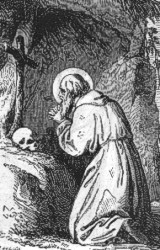 St. Sabas, abbott
Name: St. Sabas, abbott
Date: 5 December
Saint Sabas, one of the most renowned patriarchs of the monks of Palestine, was born in the year439, near Caesarea. At the age of fifteen, in the absence of his parents, he suffered under theconduct of an uncle, and weary of the world’s problems decided to forsake the world and enter amonastery not far from his family home. After he had spent ten years in religious life, his twouncles and his parents attempted to persuade him to leave the monastery to which he hadmigrated in Palestine. He replied: “Do you want me to be a deserter, leaving God after placingmyself in His service? If those who abandon the militia of earthly kings are severely punished,what chastisement would I not deserve if I abandoned that of the King of heaven?” When he was thirty years old, desiring greater solitude, he began to live an angelic life so farabove nature that he seemed no longer to have a body. The young sage, as he was called by SaintEuthymius, Abbot of a nearby monastery, dwelt in a cavern on a mountain near Jerusalem, wherehe prayed, sang Psalms and wove baskets of palm branches. He was forty-five years old when hebegan to direct those who came to live as hermits, as he did, and he gave each of them a place tobuild a cell; soon this was the largest monastery of Palestine. He left the region when certainagitators complained of him, for he considered himself incapable of maintaining good discipline. The Patriarch of Jerusalem, Sallustus, did not easily credit the complaints, and instead ordainedSabas a priest, that he might say Mass for his disciples — for they had been displeased by his lackof desire for that honor. He was at that time fifty-three years old. The Patriarch presented him tothem as their father, whom they should obey and honor, and made him Superior of all thePalestine monasteries. But several monks remained obstinate, and Saint Sabas again wentelsewhere, to a cavern near Scythopolis. As the years passed, he was in charge of seven monasteries; but his influence was not limited toPalestine. The heresies afflicting religion were being sustained by the emperor of Constantinople,who had exiled the Catholic Patriarch of that city, Elias. Saint Sabas converted the one who hadreplaced Elias, and wrote to the emperor that he should cease to persecute the Church ofJerusalem, and to impose taxes on the cities of Palestine which they were unable to pay. In effect,the people were reduced to extreme misery. The emperor died soon afterwards, and the piousJustin replaced him. Justin restored the true faith by an edict and recalled the exiles, re-establishing the exiled prelates in their sees. When Saint Sabas was ninety-one years old, he made the long journey to Constantinople to askJustinian, successor to Justin, not to act with severity against the province of Palestine, where arevolt had occurred by the non-submission of a group of Samaritans. The emperor honored himhighly and wished to endow his monasteries with wealth, but the holy Patriarch asked him to usethe riches he was offering to build a hospice for pilgrims in Jerusalem, to decorate the unfinishedChurch of the Blessed Virgin, to build a fortress where the monks could take refuge when barbarians invaded the land, and finally, to re-establish preaching of the true Faith, by edicts proscribingthe various errors being propagated. The holy Abbot lived to be ninety-two years old, and died in531, in the arms of the monks of his first monastery. |